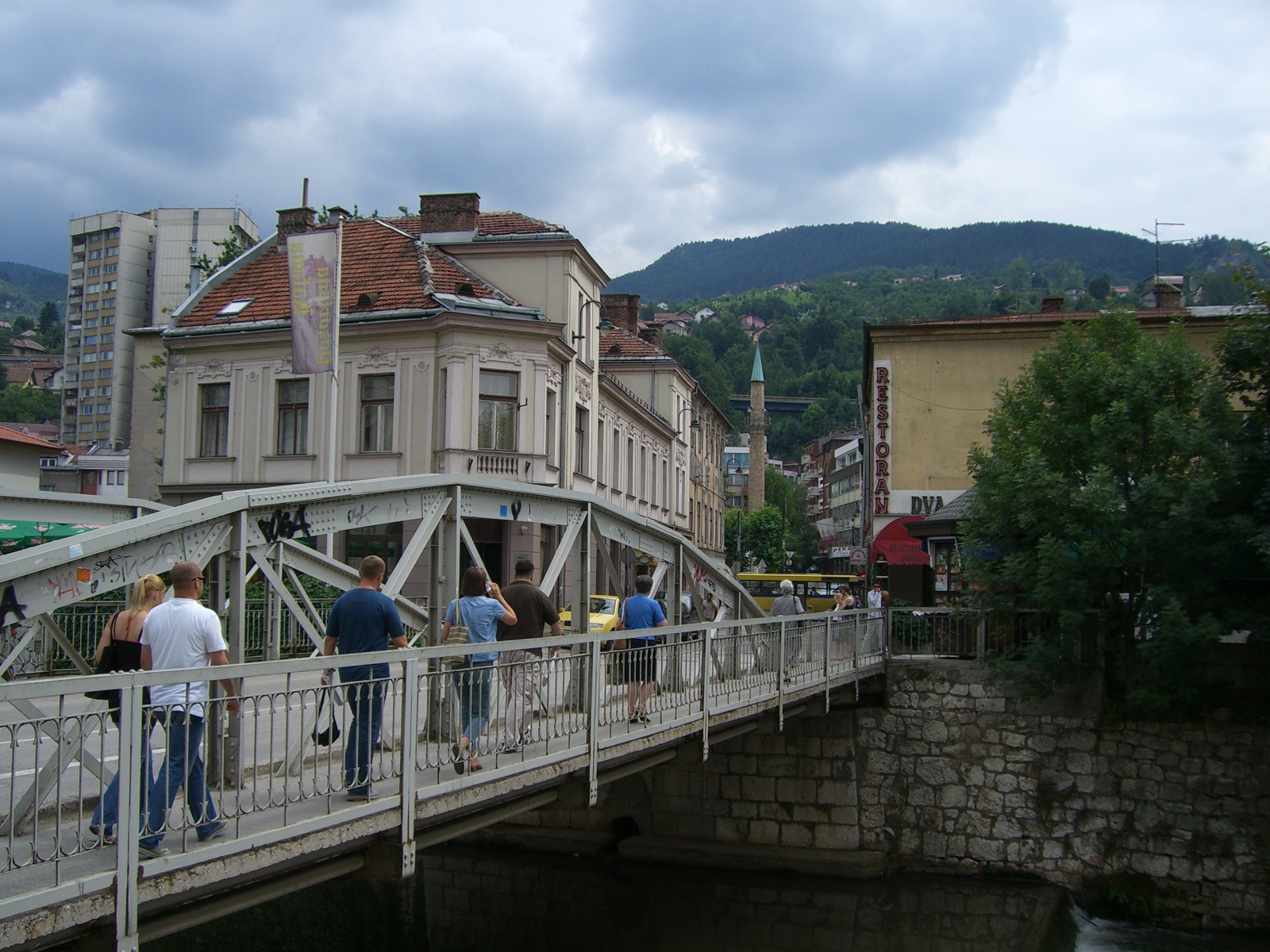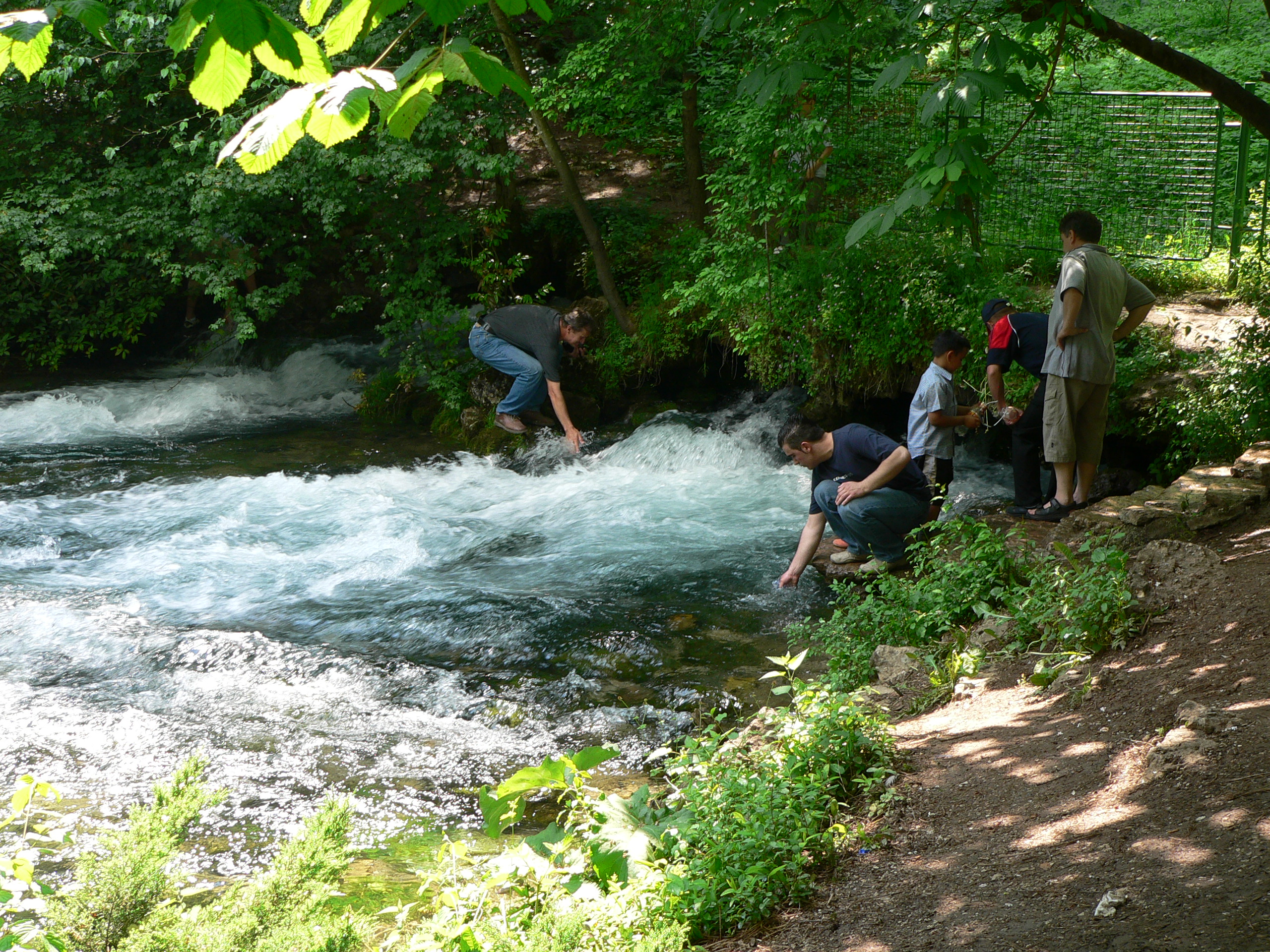|
Miljacka
The Miljacka (Serbian Cyrillic: Миљацка) is a river in Bosnia and Herzegovina that passes through Sarajevo. Numerous city bridges have been built to cross it. Characteristics The Miljacka river originates from the confluence of the Paljanska Miljacka and Mokranjska Miljacka rivers. The Miljacka is a rather small river, only long from the confluence, or and depending on source (Pale, Bosnia and Herzegovina, Pale or Mokro). By the time this tributary flows into the Bosna (river), Bosna river in Sarajevo, it has an average discharge of 5.7 m³/s. The Miljacka river flows from east to west in a general direction through the city. The Bosna is a right tributary of the Sava (river), Sava River, with its mouth in Bosanski Šamac. That river in turn flows into the Danube River, which goes southeast and enters the Black Sea chiefly in Romania. Paljanska Miljacka The Paljanska Miljacka, in length, begins at Gornje Pale, eastward in the town of Pale, under the slopes of Jaho ... [...More Info...] [...Related Items...] OR: [Wikipedia] [Google] [Baidu] |
Mokranjska Miljacka Wellspring Cave
Mokranjska Miljacka wellspring cave is the source of Mokranjska Miljacka, located about from the village of Mokro, Pale, Mokro, near Pale, Bosnia and Herzegovina, Pale. The cave is officially the longest in Bosnia and Herzegovina, with length of mapped caverns so far at , as of August 2015. The Miljacka runs out of the cave practically as an underground flow, a subterranean river, where its temperature is measured as low as 5 degrees and temperature of air as low as 8 degrees Celsius. The exact location of the cave is not yet mapped out for the public, but local authorities have released a map which can be used to find its location as well as a gallery of discoveries within the cave. New species of spiders, named ''Nemanela Lade'' ("Lada's Little Monster", namesake of its discoverer PhD Lada Lukić-Bilela from Institute for Genetic Technology, Sarajevo), along with at least five more species of spider, as well as certain species of bats, have been found there. A skeleton head of ... [...More Info...] [...Related Items...] OR: [Wikipedia] [Google] [Baidu] |
Koševski Potok
Koševski Potok is a river in Sarajevo, Bosnia and Herzegovina. The river is partially subterranean, as a significant portion of its course passing through long box culvert, covering the river in a man-made structure and diversion project, designed for gaining space for urban development since the late 1940s and early 1950s. Headwaters The Koševski Potok originates from a confluence of two smaller creeks in the region of Nahorevo neighbourhood, on the northern outskirts of Sarajevo, Nahorevski Potok and Grončavica creek (itself continuation of sinking creek called Grabovica which runs between plateaus of Crepoljsko and Biosko), draining from plateaus of Bukovik, Crepoljsko and Biosko, southeastern and southern slopes of Ozren mountain. Subterranean section The Koševski Potok enters the urban area of Sarajevo from the north, between Pionirska Dolina recreation park and neighbourhood of Koševo, and at that point is diverted underground. From this point Koševski Potok ... [...More Info...] [...Related Items...] OR: [Wikipedia] [Google] [Baidu] |
Drvenija Bridge
The Drvenija Bridge is a bridge located in Sarajevo, Bosnia and Herzegovina. The bridge was built during the Austro-Hungarian reign in 1898 and crosses the river Miljacka The Miljacka (Serbian Cyrillic: Миљацка) is a river in Bosnia and Herzegovina that passes through Sarajevo. Numerous city bridges have been built to cross it. Characteristics The Miljacka river originates from the confluence of the Palja .... External links * Bridges in Sarajevo {{BosniaHerzegovina-bridge-struct-stub ... [...More Info...] [...Related Items...] OR: [Wikipedia] [Google] [Baidu] |
Goat's Bridge
The Goat's Bridge ( Bosnian, Croatian and Serbian: ''Kozija ćuprija'' / Козја ћуприја) is a large stone bridge that crosses the Miljacka river to the east of Sarajevo, Bosnia and Herzegovina. History It was built by the Ottomans in the 16th century. It is the only fully preserved bridge from the Ottoman period which still spans the Miljacka River. The bridge, which is made primarily of white hreša (marble), is a harmonious structure with one main arch and two round openings which help support the weight. This stone material is also used to build Bijela Tabija fortress and Visegrad Gate of the nearby Vratnik fortified town. The oldest written record of this bridge was made by Mula Mustafa Bašeškija, who noted in 1771 that a stone wall was built from Kozija Ćuprija all the way to Alifakovac. Dariva Between Bentbaša and Kozija Ćuprija, there is a place called Dariva. The main attraction is its walkway that stretches for 8 km along what was once the ru ... [...More Info...] [...Related Items...] OR: [Wikipedia] [Google] [Baidu] |
Latin Bridge
Latin Bridge (Bosnian language, Bosnian, Croatian language, Croatian and Serbian language, Serbian: ''Latinska ćuprija'' / Латинска ћуприја, named ''Principov most'' / Принципов мост – "Princip's Bridge" in Yugoslavian era) is an Ottoman Empire, Ottoman bridge over the river Miljacka in Sarajevo, Bosnia and Herzegovina. The northern end of the bridge was the site of Assassination of Archduke Franz Ferdinand, the assassination of Archduke Franz Ferdinand of Austria by Gavrilo Princip in 1914, which began the July Crisis that ultimately led to the outbreak of World War I. History The bridge received its name because it connected the right bank of the Miljacka with the Catholic quarter of the city, which was informally called "Latinluk" in Ottoman times. Judging by its foundations, it is the oldest among the preserved bridges in the city. The census of the Sanjak of Bosnia from 1541 mentions the bridge on this spot, built by the leather-worker Hu ... [...More Info...] [...Related Items...] OR: [Wikipedia] [Google] [Baidu] |
Šeher-Ćehaja Bridge
Šeher Ćehaja Bridge ( Bosnian, Croatian and Serbian: ''Šeher-Ćehajina ćuprija'' / Шехер-Ћехајина ћуприја) is a bridge which crosses the River Miljacka in Sarajevo, Bosnia and Herzegovina. It can be translated as "Mayor's Bridge" from Turkish word for mayor. During the Ottoman rule, 13 bridges were built in Sarajevo.; one of the most impressive ones is Šeher Ćehaja Bridge. The only written document indicating the year of the erection of the bridge is transcript of the chronogram in Mostar indicating it was built in 994 AH (1585/1586 CE). According to the source, the bridge was constructed by a man named "Alija known as Hafizadić". The Šeher Ćehaja Bridge was damaged couple times during its existence. It happened during the huge floods of 1619 and 1629 as well as in 1843 when the Miljacka River destroyed two pillar A column or pillar in architecture and structural engineering is a structural element that transmits, through compression (physica ... [...More Info...] [...Related Items...] OR: [Wikipedia] [Google] [Baidu] |
Suada And Olga Bridge
Suada and Olga Bridge ( Bosnian, Croatian and Serbian: ''Most Suade i Olge'' / Мост Суаде и Олге), also known by its old name Vrbanja Bridge (''Vrbanja most'' / Врбања мост) is a bridge across the Miljacka river in Sarajevo. Name The oldest name of this bridge is Ćirišhana bridge, named after Turkish word for glue factory, which was located near the bridge on right side of the river. During Yugoslavian-era, name of the bridge was "Vrbanja bridge", and on 6 April 1996 it was renamed first to "Suada Dilberović bridge", after which on 3 December 1999 it was renamed to today's name "Suada and Olga bridge". It is named after Suada Dilberović and Olga Sučić, the first victims shot by Bosnian Serb's Democratic Party militia at the beginning of the Siege of Sarajevo, while a group of civilians was peacefully demonstrating. History On 19 May 1993, the couple Admira Ismić and Boško Brkić, a Bosniak and a Bosnian Serb, were also shot while trying to ... [...More Info...] [...Related Items...] OR: [Wikipedia] [Google] [Baidu] |
Festina Lente (bridge)
Festina lente (Latin for "make haste slowly") is a pedestrian bridge over the Miljacka River in Sarajevo. The bridge is 38 meters long and features an unusual looping in the middle, suggesting slowing down and enjoying the view. Conceptual design for the bridge was created by three students of the Academy of Fine Arts Sarajevo, Academy of Fine Arts in Sarajevo: Adnan Alagić, Amila Hrustić and Bojana Kanlić. The bridge connects the Mak Dizdar embankment (close to the Academy) with Radićeva street. It was officially opened on 22 August 2012. See also *Festina lente — Latin saying meaning "make haste slowly" References External links * Bridges in Sarajevo Bridges completed in 2012 {{Europe-bridge-struct-stub ... [...More Info...] [...Related Items...] OR: [Wikipedia] [Google] [Baidu] |
Novo Sarajevo
Novo Sarajevo ( sr-cyrl, Ново Сарајево, ; lit. "New Sarajevo") is a municipality of the city of Sarajevo, Bosnia and Herzegovina. Neighborhoods *'' Grbavica I'' *'' Grbavica II'' *''Pofalići I'' *''Pofalići II'' *''Velešići'' *''Gornji Velešići'' *''Željeznička'' *''Dolac Malta'' *''Čengić Vila I'' *''Kvadrant'' *''Čengić Vila II'' *''Hrasno'' *''Hrasno Brdo'' *''Trg Heroja'' *''Kovačići'' *''Gornji Kovačići'' *''Vraca'' History Like Novi Grad, Novo Sarajevo is a product of the city's massive growth and development in the 1960s and 1970s. It is located in the middle of the Sarajevo field, predominantly on the northern bank of the Miljacka, between Novi Grad and Centar. Prior to the siege, Novo Sarajevo had some 47.6 km² (41.6% Forest, 17.5% Meadows, 13.5% Commercial/Building Land, 10.4% Grass-land, 8.4% Ploghland, 13.5% Gardens). Following the siege of Sarajevo, 75% of the lesser populated urban area was transferred to Republika Srpska (establi ... [...More Info...] [...Related Items...] OR: [Wikipedia] [Google] [Baidu] |
Skenderija Bridge
The Skenderija Bridge (also called Ajfel or Ajfelov most) is a footbridge located in Sarajevo, Bosnia and Herzegovina opposite the Skenderija Centre which crosses the River Miljacka. It was designed by Gustave Eiffel. The bridge is home to a small number of love locks A love lock or love padlock is a padlock that significant other pairs lock to a bridge, fence, gate, monument, or similar public fixture to symbolize their love. Typically the sweethearts' names or initials, and perhaps the date, are inscribed ..., a phenomenon practiced by lovers on various European, Asian and Australian bridges. External links * Bridges in Sarajevo Gustave Eiffel's designs {{BosniaHerzegovina-bridge-struct-stub ... [...More Info...] [...Related Items...] OR: [Wikipedia] [Google] [Baidu] |
Čobanija Bridge
The Čobanija Bridge is an iron bridge, located in Sarajevo, Bosnia and Herzegovina Bosnia and Herzegovina ( sh, / , ), abbreviated BiH () or B&H, sometimes called Bosnia–Herzegovina and often known informally as Bosnia, is a country at the crossroads of south and southeast Europe, located in the Balkans. Bosnia and H ..., which crosses the River Miljacka. It was erected in 1887. The bridge stands on a site previously occupied by a wooden bridge, known as the Šejhanija bridge, which had been built in the 16th century. References Bridges in Sarajevo {{BosniaHerzegovina-bridge-struct-stub ... [...More Info...] [...Related Items...] OR: [Wikipedia] [Google] [Baidu] |
Bosna River
The Bosna () is the third longest river in Bosnia and Herzegovina, and is considered one of the country's three major internal rivers, along with the Neretva and the Vrbas. The other three major rivers of Bosnia and Herzegovina are the Una, to the northwest; the Sava, to the north, and the Drina, to the east. This river is the namesake of Bosnia. The river Bosna flows for . The river is possibly mentioned for the first time during the 1st century AD by Roman historian Marcus Velleius Paterculus under the name ''Bathinus flumen''. Another basic source that is associated with the hydronym ''Bathinus'' is the Salonitan inscription of the governor of Dalmatia, Publius Cornelius Dolabella, where it is said that the ''Bathinum'' river divides the Breuci from the Osseriates. And also by the name of Basante. There was also the name Bason on the map ''From Istanbul to Vienna'' along the Danube and the Black Sea — a river-centric map by the Venetian cartographer Stefano Scolari, c. ... [...More Info...] [...Related Items...] OR: [Wikipedia] [Google] [Baidu] |

.jpg)

